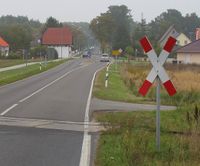Key:crossing:barrier
Jump to navigation
Jump to search
| Description |
|---|
| Type of gates on a railway level crossing. |
| Group: railways |
| Used on these elements |
| Requires |
| Useful combination |
| Status: de facto |
| Tools for this tag |
|
The tag crossing:barrier=* is used to specify which type of gates the railway level crossing has.
How to map
Use the tag on a node ![]() . The node should be shared between the highway and railway.
. The node should be shared between the highway and railway.
- railway=level_crossing / railway=crossing obligatory
- crossing:barrier=* the type of gates
- crossing:barrier=no - no gates
- crossing:barrier=full - full-width gates
- crossing:barrier=double_half - two half-width gates on each approach, barring both the entry and exit
- crossing:barrier=half - a half-width gate on each approach, barring the entry but leaving the exit free
- crossing:barrier=yes - gates (to use when you do not know a more precise value)
Sidewalks and cycle lanes
When the value for the roadway is half, but the sidewalks or cycle lanes have barriers on both approaches:
- crossing:barrier:footway=full - sidewalks
- crossing:barrier:cycleway=full - cycle lanes
Of course, when the sidepaths are mapped as separate ![]() ways, do not use these tags. Instead, add the barrier information on their crossing nodes.
ways, do not use these tags. Instead, add the barrier information on their crossing nodes.
Tags used in combination
- supervised=* - indicates whether there is a person who supervises the place
- crossing:activation=* - the way of operation
- crossing:activation=automatic - automatic (by contacts)
- crossing:activation=remote - remotely operated (by train dispatcher)
- crossing:activation=local - locally operated (by guard or train personal)
- crossing:light=* - visual warning of crossing closure
- crossing:saltire=* - diagonal cross sign (usually present)
- crossing:on_demand=* - on-demand operation
- crossing:bell=* - audible warning of crossing closure




